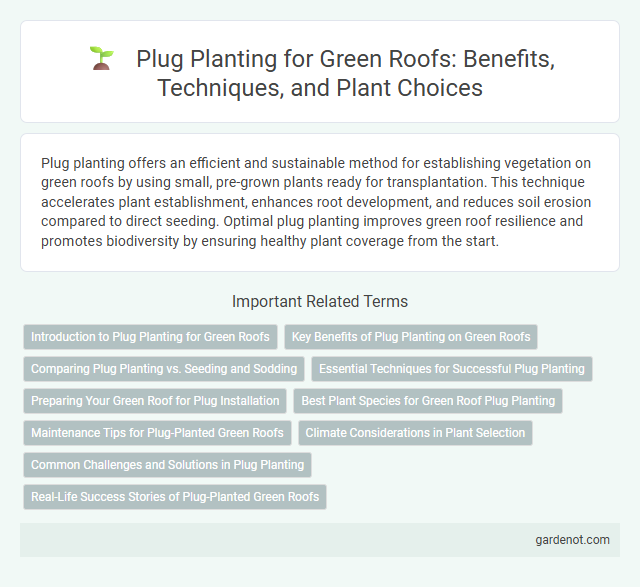Plug planting offers an efficient and sustainable method for establishing vegetation on green roofs by using small, pre-grown plants ready for transplantation. This technique accelerates plant establishment, enhances root development, and reduces soil erosion compared to direct seeding. Optimal plug planting improves green roof resilience and promotes biodiversity by ensuring healthy plant coverage from the start.
Introduction to Plug Planting for Green Roofs
Plug planting for green roofs involves transplanting young, pre-rooted plants directly into the growing medium to ensure rapid establishment and improved survival rates. This method enhances vegetation density and diversity, which contributes to increased stormwater retention, thermal regulation, and biodiversity on green roof systems. Using native or drought-tolerant species as plugs supports sustainable green roof ecosystems and reduces maintenance requirements.
Key Benefits of Plug Planting on Green Roofs
Plug planting on green roofs enhances plant establishment by providing young, robust seedlings that adapt quickly to rooftop conditions, improving survival rates. This method reduces water usage and maintenance needs due to efficient root development and faster canopy closure. Increased biodiversity and soil stabilization are achieved through the targeted placement of diverse species, promoting ecological balance and minimizing erosion risks.
Comparing Plug Planting vs. Seeding and Sodding
Plug planting offers faster establishment and higher survival rates compared to seeding, as mature seedlings withstand harsh conditions better. Unlike sodding, which provides immediate ground cover but is costlier and less adaptable to varied roof structures, plug planting balances affordability and adaptability for green roofs. This method reduces irrigation needs and minimizes soil erosion, promoting sustainable green roof development.
Essential Techniques for Successful Plug Planting
Plug planting requires selecting healthy, well-rooted seedlings with strong stems to ensure robust establishment on green roofs. Proper spacing and depth are critical, as plugs must be planted at the same soil level they were grown to prevent root stress and promote rapid growth. Maintaining consistent moisture and providing initial shading are essential techniques that enhance survival rates and encourage healthy root development in green roof environments.
Preparing Your Green Roof for Plug Installation
Preparing your green roof for plug planting involves ensuring a well-drained, nutrient-rich growing medium that supports root development and water retention. It is essential to evenly level the substrate and remove any debris or weeds to promote uniform plug growth and prevent competition. Proper preparation includes checking irrigation systems and maintaining optimal moisture levels to enhance plug establishment and long-term plant health.
Best Plant Species for Green Roof Plug Planting
Sedum species such as Sedum album and Sedum acre excel in green roof plug planting due to their drought tolerance and shallow root systems that thrive in thin substrates. Native grasses like Festuca ovina provide durability and low maintenance, supporting soil stabilization and biodiversity. Succulents and herbaceous perennials including Sempervivum and Dianthus contribute to ecological resilience and aesthetic diversity in green roof systems.
Maintenance Tips for Plug-Planted Green Roofs
Regular watering is essential for plug-planted green roofs, especially during the initial establishment phase to ensure root development and plant survival. Monitor for invasive weeds and remove them promptly to reduce competition for nutrients and maintain plant health. Fertilize with a balanced, slow-release formula tailored to the native species used, supporting sustained growth and resilience in the rooftop environment.
Climate Considerations in Plant Selection
Selecting plants for plug planting on green roofs requires careful consideration of local climate conditions such as temperature extremes, rainfall patterns, and wind exposure. Drought-tolerant species like Sedum and native grasses enhance survival rates and reduce irrigation needs under variable weather. Climate-adapted plants also improve green roof performance by supporting biodiversity and reducing urban heat island effects.
Common Challenges and Solutions in Plug Planting
Plug planting in green roofs often faces challenges such as poor root establishment, water stress, and substrate compaction. Solutions include selecting drought-tolerant plant species, optimizing irrigation systems, and using lightweight, well-aerated growing media to enhance root development. Regular monitoring and timely maintenance prevent plant stress and ensure successful plug establishment in extensive green roof systems.
Real-Life Success Stories of Plug-Planted Green Roofs
Plug planting on green roofs has demonstrated remarkable success in urban environments, significantly enhancing biodiversity and stormwater management. Projects like the Chicago City Hall green roof and the Vancouver Convention Centre have shown rapid vegetation establishment and increased thermal insulation. These real-life examples highlight plug planting as an efficient technique for sustainable urban development and climate resilience.
Plug planting Infographic

 gardenot.com
gardenot.com